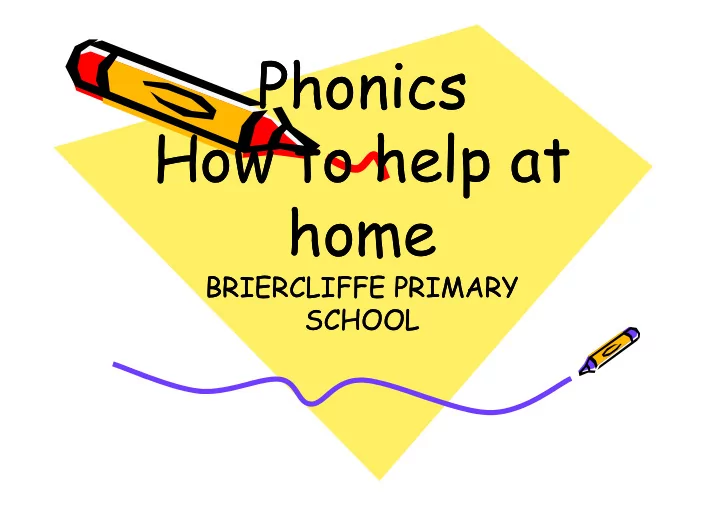

Phonics Phonics How to help at How to help at home home BRIERCLIFFE PRIMARY BRIERCLIFFE PRIMARY SCHOOL SCHOOL
Phonics Scheme • At Briercliffe, we use Letters and Sounds across Key Stage 1 and the EYFS. In Year 2, children work from Support for Spelling. Some children may need to continue with phonic type activities into KS2 if they have not fully grasped all the necessary sounds.
• Most important thing – From a very early age… • Talking and Listening. • Reading with and to your child • Playing listening games • Singing songs and rhymes • Simple movement games All these things will help to build up connections in the brain, an enjoyment of language and confidence to try things out.
• PHONICS • Correct pronunciation • Correct vocabulary • We all need to use the same language at home and at school. • Little and often is the key. Does not have to be formal. • Link it to your child’s interests.
PHONEME • The smallest unit of sound in a word. • There are 44 phonemes that we teach.
The 44 phonemes /b/ /d/ /f/ /g/ /h/ /j/ /k/ /l/ /m/ /n/ /ng/ /p/ /r/ /s/ /t/ /v/ /w/ /y/ /z/ /th/ /th/ /ch/ /sh/ /ng/ /a/ /e/ /i/ /o/ /u/ /ai/ /ee/ /igh/ /oa / /oo/ /oo/ /ar/ /ur/ /or/ /er/ /ow/ /oi/ /air/ /ear/ /ure/
GRAPHEME • Letters representing a phoneme e.g. c ai igh Children need to practise recognising the grapheme and saying the phoneme that it represents.
BLENDING • Recognising the letter sounds in a written word, for example c-u-p and merging or ‘blending’ them in the order in which they are written to pronounce the word ‘cup’
SEGMENTING • ‘Chopping Up’ the word to spell it out • The opposite of blending • Use your ‘PHONEME FINGERS’
Segment and Blend these words… •drep •blom •gris Nonsense games like this help to build up skills – and are fun!
Once children are good with single phonemes… • DIGRAPHS – 2 letters that make 1 sound ll ss zz oa ai • TRIGRAPHS – 3 letters that make 1 sound igh ear
Segmenting Activity • Use your ‘phoneme fingers’ to say how many phonemes in each word. • shelf • dress • sprint • string
Did you get it right? • shelf = sh – e – l – f = 4 phonemes • dress = d - r - e – ss = 4 phonemes • sprint = s – p – r – i – n – t = 6 phonemes • string = s – t – r – i – ng = 5 phonemes
TRICKY WORDS • Words that are not phonically decodable • e.g. was, the, I • Some are ‘tricky’ to start with but will become decodable once we have learned the harder phonemes • e.g. out, there,
Now you have the knowledge…. • Play lots of sound and listening games with your child. • Read as much as possible to and with your child. • Encourage and praise – get them to have a ‘good guess’. • Ask your child’s teacher if you want to know more.
Useful websites • www.parentsintouch.co.uk • www.bbc.co.uk/schools/parents • www.jollylearning.co.uk • www.focusonphonics.co.uk • www.syntheticphonics.com
Recommend
More recommend